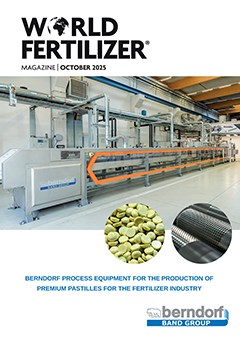Editorial comment
Whether you love it or you hate it, Artificial Intelligence (AI) is here to stay. The floodgates have been opened and across the globe industries are figuring out how to adapt to this new paradigm. Almost every industry has been trying to find a way to usefully implement AI to assist and enhance existing processes; the global agriculture industry is no different.
Register for free »
Get started now for absolutely FREE, no credit card required.
But what does this mean for the fertilizer industry? For many it smells of opportunity. Already there are projects like Fertilizer AI which aims to demonstrate that the prediction of optimal fertilization timings and amounts using a short-term forecast is feasible. The project has even received funding from the EU’s European Research Council.1
The benefits of AI implementation in the fertilizer industry are clear. Most obviously, it can optimise production and distribution, utilising machine learning (ML) algorithms to improve data analysis and run simulations of potential, real-world scenarios. When developed for the purposes of predictive maintenance it can even be used to identify problems and faults at the earliest point possible. Tools like the US Department of Agriculture’s (USDA’s) Integrated Farm System Model (IFSM) makes use of ML to simulate runoff, leaching, and degradation of fertilizers.2 Moreover, AI can enhance the application of fertilizers in agriculture by calculating the most optimal distribution to maximise yield and by coordinating fertilizer deployment using drones and other automatic systems. Yara International has been working on this type of enhancement with its N-Sensor technology combining AI with drones and satellite imagery to make real-time adjustments to nitrogen-based fertilizer application.2 There is also the question of ecological impact and sustainability with AI having the potential to identify flaws in existing production and distribution systems that produce excessive carbon emissions and create significant amounts of waste.
But AI is certainly not without its flaws. At present there are limitations in the amount of comprehensive and accurate data available to AI systems which require accurate data to work effectively. The data that is accurate and available is not widespread and for agrarian nations, such as India, and that presents a real problem for furthering the implementation of AI in those markets. Without accessible data to input into these AI systems, they are hamstrung. Another, wide-reaching drawback is the direct ecological impact of AI. Data centres are at the heart of this problem. They are used to house and operate these AI systems and have a voracious appetite for electric energy and power; largely used for cooling systems that counteract the amount of heat that these sites give off. Data centres consume vast amounts of water and require crucial rare minerals in large quantities. AI currently requires an unsustainable amount of resources to operate.
AI is rapidly transforming how we approach challenges in the fertilizer industry – ushering in an era of agrochemistry more strongly supported by digital technologies. With new developments every day, AI could help enable smarter, more sustainable farming practices. The fertilizer industry needs to take advantage of this technology and use it as it has ultimately been intended, which is as a tool designed to assist humanity and make these processes easier.
References


